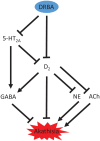Dopamine-receptor blocking agent-associated akathisia: a summary of current understanding and proposal for a rational approach to treatment
- PMID: 32922732
- PMCID: PMC7457694
- DOI: 10.1177/2045125320937575
Dopamine-receptor blocking agent-associated akathisia: a summary of current understanding and proposal for a rational approach to treatment
Abstract
Dopamine-receptor blocking agent-associated akathisia (DRBA-A) is an adverse effect that can significantly limit the use of these important medications for the treatment of a variety of psychiatric diseases, yet there is no unifying theory regarding its pathophysiology. This knowledge gap limits clinicians' ability to effectively manage DRBA-A and mitigate negative outcomes in an already vulnerable patient population. Based on a review of the current literature on the subject, it is hypothesized that dopaminergic and noradrenergic signaling is perturbed in DRBA-A. Accordingly, it is proposed that the optimal agent to manage this extrapyramidal symptom should increase dopamine signaling in the affected areas of the brain and counteract compensatory noradrenergic signaling via antagonism of adrenergic or serotonergic receptors.
Keywords: akathisia; antipsychotic; dopamine receptor blocking agent; extrapyramidal symptom; mechanism; treatment.
© The Author(s), 2020.
Conflict of interest statement
Conflict of interest statement: The authors declare that there is no conflict of interest.
Figures

Similar articles
-
The nosology of tardive syndromes.J Neurol Sci. 2018 Jun 15;389:10-16. doi: 10.1016/j.jns.2018.02.008. Epub 2018 Feb 6. J Neurol Sci. 2018. PMID: 29433810
-
Tardive dyskinesia: Who gets it and why.Parkinsonism Relat Disord. 2019 Feb;59:151-154. doi: 10.1016/j.parkreldis.2018.11.017. Epub 2018 Nov 15. Parkinsonism Relat Disord. 2019. PMID: 30522959 Review.
-
Severe akathisia during olanzapine treatment of acute schizophrenia.Pharmacopsychiatry. 1998 Jul;31(4):146-8. doi: 10.1055/s-2007-979317. Pharmacopsychiatry. 1998. PMID: 9754850
-
Current topics in neuroleptic-induced extrapyramidal symptoms in Japan.Keio J Med. 1996 Jun;45(2):95-9. doi: 10.2302/kjm.45.95. Keio J Med. 1996. PMID: 8683905 Review.
-
Serotonergic modulation of dopamine neurotransmission: a mechanism for enhancing therapeutics in schizophrenia.J Coll Physicians Surg Pak. 2006 Aug;16(8):556-62. J Coll Physicians Surg Pak. 2006. PMID: 16899192 Review.
Cited by
-
Single-Nucleotide Polymorphisms as Biomarkers of Antipsychotic-Induced Akathisia: Systematic Review.Genes (Basel). 2023 Feb 28;14(3):616. doi: 10.3390/genes14030616. Genes (Basel). 2023. PMID: 36980888 Free PMC article.
-
The role of lumateperone in the treatment of schizophrenia.Ther Adv Psychopharmacol. 2021 Jul 31;11:20451253211034019. doi: 10.1177/20451253211034019. eCollection 2021. Ther Adv Psychopharmacol. 2021. PMID: 34377435 Free PMC article. Review.
-
Akathisia and oculogyric crisis in hyperemesis gravidarum.Obstet Med. 2024 Jun;17(2):129-131. doi: 10.1177/1753495X221137942. Epub 2022 Nov 13. Obstet Med. 2024. PMID: 38784181 Free PMC article.
-
Antidepressant-induced Paradoxical Anxiety, Akathisia, and Complex Vocal Tics in a Patient with Panic Disorder and Crohn's Disease: A Case Report.Curr Drug Saf. 2024;19(4):478-481. doi: 10.2174/0115748863270093231114075934. Curr Drug Saf. 2024. PMID: 38251693
-
Overview of Movement Disorders Secondary to Drugs.Clin Pract. 2023 Aug 18;13(4):959-976. doi: 10.3390/clinpract13040087. Clin Pract. 2023. PMID: 37623268 Free PMC article. Review.
References
-
- Belmaker RH, Wald D. Haloperidol in normals. Br J Psychiatry 1977; 131: 222–223. - PubMed
-
- Lohr JB, Eidt CA, Abdulrazzaq Alfaraj A, et al. The clinical challenges of akathisia. CNS Spectr 2015; 20(Suppl. 1): 1–14; quiz 5–6. - PubMed
-
- Kim JH, Byun HJ. Association of subjective cognitive dysfunction with akathisia in patients receiving stable doses of risperidone or haloperidol. J Clin Pharm Ther 2007; 32: 461–467. - PubMed
-
- Sachdev PS, Brune M. Animal models of acute drug-induced akathisia - a review. Neurosci Biobehav Rev 2000; 24: 269–277. - PubMed
-
- Kane JM, Fleischhacker WW, Hansen L, et al. Akathisia: an updated review focusing on second-generation antipsychotics. J Clin Psychiatry 2009; 70: 627–643. - PubMed
Publication types
LinkOut - more resources
Full Text Sources
Miscellaneous

